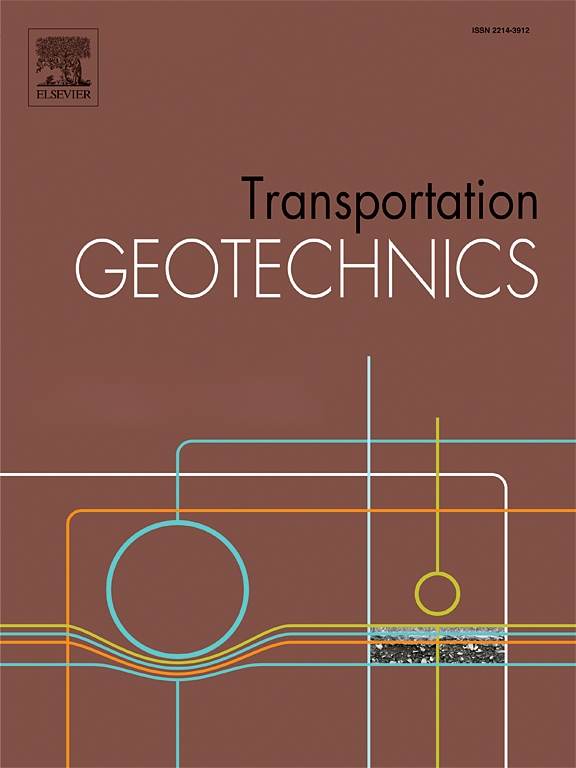In-Situ Plate Load Test Measurements of Stress Distribution Properties for Coarse Unbound Granular Materials
IF 5.5
2区 工程技术
Q1 ENGINEERING, CIVIL
引用次数: 0
Abstract
A field test was conducted to study in-situ stress distribution of coarse crushed rock (CR) materials. The existing literature on CR materials with upper sieve size > 90 mm is very limited, and there is a need to characterize these materials and validate the application of existing theory and models for unbound granular materials.
The objective of this paper is to compare plate loading test (PLT) measurements on two CR subbase materials, and to analyze and compare computed and measured vertical stresses below subbase layers of these materials: open-graded CR 22/125 mm and dense-graded CR 0/125 mm. Earth pressure cells (EPCs) were installed to measure vertical stress at 0.6 m depth, σ0.6, during static PLTs with 300 mm plate diameter. The ratio of σ0.6 to the average stress at the surface, σ0, was compared with outputs from Boussinesq’s theory and multilayer nonlinear analyses in KENPAVE.
The average σ0.6 for all loading levels during the second cycle of PLT was 41% higher for CR 22/125 as compared to CR 0/125. The average ratio Δσ0.6/Δσ0 for EPC measurements were 12.4% and 9.7% for CR 22/125 and CR 0/125, respectively. Based on Boussinesq’s theory, Δσ0.6/Δσ0 was 8.7%. Computed with KENPAVE, the average Δσ0.6/Δσ0 was 5.4% for both sections.
The EPC measurements indicate better load distribution properties for dense-graded as compared to open-graded CR. These findings could be applied for empiric design systems by differentiating the load distribution parameters of such materials. Furthermore, the results indicate a need to validate the application of analytical or mechanistic-empirical pavement design tools for pavement structures comprising coarse CR materials.
粗散颗粒材料应力分布特性的原位板载试验测量
通过现场试验研究了粗粒碎石材料的地应力分布规律。现有文献对CR材料的上筛尺寸>;90mm是非常有限的,有必要对这些材料进行表征,并验证现有理论和模型在非束缚颗粒材料中的应用。本文的目的是比较两种CR亚基材料的板加载试验(PLT)测量结果,并分析和比较这些材料的亚基层以下的计算和测量垂直应力:开级CR 22/125 mm和密级CR 0/125 mm。安装土压力计(EPCs)测量板径为300 mm的静态plt在0.6 m深度处的垂直应力,σ0.6。将σ0.6与表面平均应力σ0的比值与Boussinesq理论和KENPAVE的多层非线性分析结果进行了比较。在PLT的第二个循环中,CR 22/125的所有加载水平的平均σ0.6比CR 0/125高41%。对于CR 22/125和CR 0/125, EPC测量的平均比值Δσ0.6/Δσ0分别为12.4%和9.7%。根据Boussinesq的理论,Δσ0.6/Δσ0为8.7%。用KENPAVE计算,两个部分的平均Δσ0.6/Δσ0为5.4%。EPC测量结果表明,与开级CR相比,密级CR具有更好的载荷分布特性。通过区分这类材料的载荷分布参数,这些发现可以应用于经验设计系统。此外,研究结果表明,需要验证分析或力学经验路面设计工具在含粗CR材料的路面结构中的应用。
本文章由计算机程序翻译,如有差异,请以英文原文为准。
求助全文
约1分钟内获得全文
求助全文
来源期刊

Transportation Geotechnics
Social Sciences-Transportation
CiteScore
8.10
自引率
11.30%
发文量
194
审稿时长
51 days
期刊介绍:
Transportation Geotechnics is a journal dedicated to publishing high-quality, theoretical, and applied papers that cover all facets of geotechnics for transportation infrastructure such as roads, highways, railways, underground railways, airfields, and waterways. The journal places a special emphasis on case studies that present original work relevant to the sustainable construction of transportation infrastructure. The scope of topics it addresses includes the geotechnical properties of geomaterials for sustainable and rational design and construction, the behavior of compacted and stabilized geomaterials, the use of geosynthetics and reinforcement in constructed layers and interlayers, ground improvement and slope stability for transportation infrastructures, compaction technology and management, maintenance technology, the impact of climate, embankments for highways and high-speed trains, transition zones, dredging, underwater geotechnics for infrastructure purposes, and the modeling of multi-layered structures and supporting ground under dynamic and repeated loads.
 求助内容:
求助内容: 应助结果提醒方式:
应助结果提醒方式:


